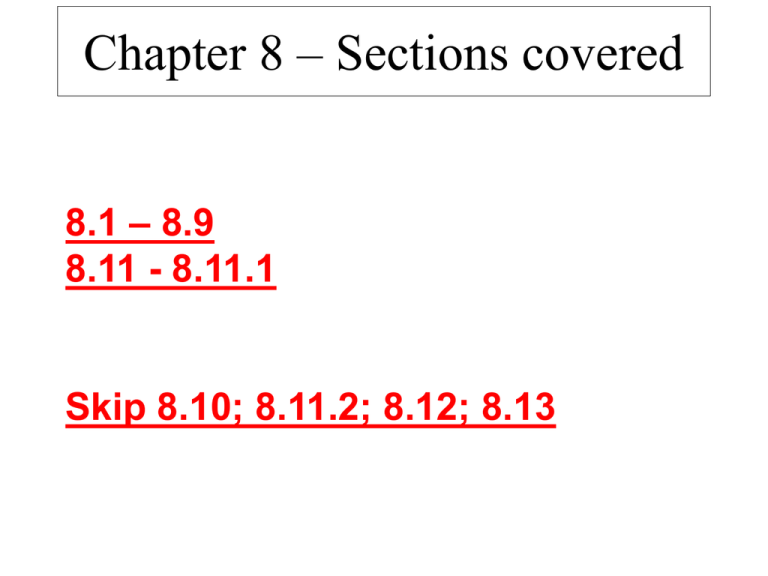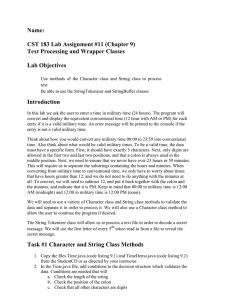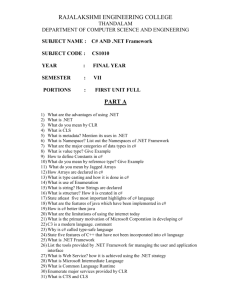
Chapter 8 – Sections covered
8.1 – 8.9
8.11 - 8.11.1
Skip 8.10; 8.11.2; 8.12; 8.13
Final exam
Will be cumulative (more details
soon)
It will be given on Thursday,
December 18th from 4:00 to 5:50
pm in room 810 Silver.
Schedule for the rest of the semester
•
•
•
•
Nov 24
Dec 2
Dec 4
Dec 9
Strings
terms and rules
odds & ends; review
review
4
Casting Objects
It is always possible to convert a subclass to a superclass. For this
reason, explicit casting can be omitted. For example,
Circle myCircle = myCylinder
is equivalent to
Circle myCircle = (Circle)myCylinder;
2003 Prentice Hall, Inc. All rights reserved.
From Liang book
5
Casting from
Superclass to Subclass
Explicit casting must be used when casting an object from a
superclass to a subclass. This type of casting may not always
succeed.
Cylinder myCylinder = (Cylinder)myCircle;
2003 Prentice Hall, Inc. All rights reserved.
From Liang book
6
The instanceof Operator
Use the instanceof operator to test whether an object is
an instance of a class:
Circle myCircle = new Circle();
if (myCircle instanceof Cylinder) {
Cylinder myCylinder = (Cylinder)myCircle;
...
}
2003 Prentice Hall, Inc. All rights reserved.
From Liang book
7
10.7 Case Study: Payroll System Using
Polymorphism
• Create a payroll program
– Use abstract methods and polymorphism
• Problem statement
– 4 types of employees, paid weekly
•
•
•
•
Salaried (fixed salary, no matter the hours)
Hourly (overtime [>40 hours] pays time and a half)
Commission (paid percentage of sales)
Base-plus-commission (base salary + percentage of sales)
– Boss wants to raise pay by 10%
2003 Prentice Hall, Inc. All rights reserved.
8
10.9 Case Study: Payroll System Using
Polymorphism
• Superclass Employee
– Abstract method earnings (returns pay)
• abstract because need to know employee type
• Cannot calculate for generic employee
– Other classes extend Employee
Employee
SalariedEmployee
CommissionEmployee
BasePlusCommissionEmployee
2003 Prentice Hall, Inc. All rights reserved.
HourlyEmployee
9
1
2
3
4
5
6
7
8
9
10
11
12
13
14
15
16
17
18
19
20
21
22
Outline
// Fig. 10.12: Employee.java
// Employee abstract superclass.
public abstract class Employee {
private String firstName;
private String lastName;
private String socialSecurityNumber;
Declares class Employee
as abstract class.
// constructor
public Employee( String first, String last, String ssn )
{
firstName = first;
lastName = last;
socialSecurityNumber = ssn;
}
Employee.java
Line 4
Declares class
Employee as
abstract class.
// set first name
public void setFirstName( String first )
{
firstName = first;
}
2003 Prentice Hall, Inc.
All rights reserved.
10
23
24
25
26
27
28
29
30
31
32
33
34
35
36
37
38
39
40
41
42
43
44
45
46
// return first name
public String getFirstName()
{
return firstName;
}
Outline
Employee.java
// set last name
public void setLastName( String last )
{
lastName = last;
}
// return last name
public String getLastName()
{
return lastName;
}
// set social security number
public void setSocialSecurityNumber( String number )
{
socialSecurityNumber = number; // should validate
}
2003 Prentice Hall, Inc.
All rights reserved.
11
47
48
49
50
51
52
53
54
55
56
57
58
59
60
61
62
63
Outline
// return social security number
public String getSocialSecurityNumber()
{
return socialSecurityNumber;
}
Employee.java
// return String representation of Employee object
public String toString()
{
return getFirstName() + " " + getLastName() +
"\nsocial security number: " + getSocialSecurityNumber();
}
// abstract method overridden by subclasses
public abstract double earnings();
Line 61
Abstract method
overridden by
subclasses.
Abstract method
overridden by subclasses
} // end abstract class Employee
2003 Prentice Hall, Inc.
All rights reserved.
1
2
3
4
5
6
7
8
9
10
11
12
13
14
15
16
17
18
19
20
21
22
23
24
25
26
// Fig. 10.13: SalariedEmployee.java
// SalariedEmployee class extends Employee.
12
Outline
public class SalariedEmployee extends Employee {
private double weeklySalary;
// constructor
Use superclass
public SalariedEmployee( String first, String last,
basic fields.
String socialSecurityNumber, double salary )
{
super( first, last, socialSecurityNumber );
setWeeklySalary( salary );
}
SalariedEmploye
e.java
constructor for
Line 11
Use superclass
constructor for basic
fields.
// set salaried employee's salary
public void setWeeklySalary( double salary )
{
weeklySalary = salary < 0.0 ? 0.0 : salary;
}
// return salaried employee's salary
public double getWeeklySalary()
{
return weeklySalary;
}
2003 Prentice Hall, Inc.
All rights reserved.
13
27
28
29
30
31
32
33
34
35
36
37
38
39
40
// calculate salaried employee's pay;
// override abstract method earnings in Employee
public double earnings()
{
return getWeeklySalary();
}
Must implement abstract
method earnings.
// return String representation of SalariedEmployee object
public String toString()
{
return "\nsalaried employee: " + super.toString();
}
Outline
SalariedEmploye
e.java
Lines 29-32
Must implement
abstract method
earnings.
} // end class SalariedEmployee
2003 Prentice Hall, Inc.
All rights reserved.
1
2
3
4
5
6
7
8
9
10
11
12
13
14
15
16
17
18
19
20
21
22
23
24
25
26
27
28
// Fig. 10.14: HourlyEmployee.java
// HourlyEmployee class extends Employee.
public class HourlyEmployee extends Employee {
private double wage;
// wage per hour
private double hours; // hours worked for week
14
Outline
HourlyEmployee.
java
// constructor
public HourlyEmployee( String first, String last,
String socialSecurityNumber, double hourlyWage, double hoursWorked )
{
super( first, last, socialSecurityNumber );
setWage( hourlyWage );
setHours( hoursWorked );
}
// set hourly employee's wage
public void setWage( double wageAmount )
{
wage = wageAmount < 0.0 ? 0.0 : wageAmount;
}
// return wage
public double getWage()
{
return wage;
}
2003 Prentice Hall, Inc.
All rights reserved.
29
30
31
32
33
34
35
36
37
38
39
40
41
42
43
44
45
46
47
48
49
50
51
52
53
54
55
56
57
58
// set hourly employee's hours worked
public void setHours( double hoursWorked )
{
hours = ( hoursWorked >= 0.0 && hoursWorked <= 168.0 ) ?
hoursWorked : 0.0;
}
// return hours worked
public double getHours()
{
return hours;
}
15
Outline
HourlyEmployee.
java
Lines 44-50
Must implement
abstract method
earnings.
// calculate hourly employee's pay;
// override abstract method earnings in Employee
public double earnings()
Must implement abstract
{
method earnings.
if ( hours <= 40 ) // no overtime
return wage * hours;
else
return 40 * wage + ( hours - 40 ) * wage * 1.5;
}
// return String representation of HourlyEmployee object
public String toString()
{
return "\nhourly employee: " + super.toString();
}
} // end class HourlyEmployee
2003 Prentice Hall, Inc.
All rights reserved.
1
2
3
4
5
6
7
8
9
10
11
12
13
14
15
16
17
18
19
20
21
22
23
24
25
26
27
28
// Fig. 10.15: CommissionEmployee.java
// CommissionEmployee class extends Employee.
public class CommissionEmployee extends Employee {
private double grossSales;
// gross weekly sales
private double commissionRate; // commission percentage
16
Outline
CommissionEmplo
yee.java
// constructor
public CommissionEmployee( String first, String last,
String socialSecurityNumber,
double grossWeeklySales, double percent )
{
super( first, last, socialSecurityNumber );
setGrossSales( grossWeeklySales );
setCommissionRate( percent );
}
// set commission employee's rate
public void setCommissionRate( double rate )
{
commissionRate = ( rate > 0.0 && rate < 1.0 ) ? rate : 0.0;
}
// return commission employee's rate
public double getCommissionRate()
{
return commissionRate;
}
2003 Prentice Hall, Inc.
All rights reserved.
29
30
31
32
33
34
35
36
37
38
39
40
41
42
43
44
45
46
47
48
49
50
51
52
53
54
55
17
Outline
// set commission employee's weekly base salary
public void setGrossSales( double sales )
{
grossSales = sales < 0.0 ? 0.0 : sales;
}
CommissionEmplo
yee.java
// return commission employee's gross sales amount
public double getGrossSales()
{
return grossSales;
}
Lines 44-47
Must implement
abstract method
earnings.
// calculate commission employee'sMust
pay; implement abstract
// override abstract method earnings
in Employee
method
earnings.
public double earnings()
{
return getCommissionRate() * getGrossSales();
}
// return String representation of CommissionEmployee object
public String toString()
{
return "\ncommission employee: " + super.toString();
}
} // end class CommissionEmployee
2003 Prentice Hall, Inc.
All rights reserved.
18
1
2
3
4
5
6
7
8
9
10
11
12
13
14
15
16
17
18
19
20
21
22
23
24
25
26
27
// Fig. 10.16: BasePlusCommissionEmployee.java
// BasePlusCommissionEmployee class extends CommissionEmployee.
public class BasePlusCommissionEmployee extends CommissionEmployee {
private double baseSalary; // base salary per week
// constructor
public BasePlusCommissionEmployee( String first, String last,
String socialSecurityNumber, double grossSalesAmount,
double rate, double baseSalaryAmount )
{
super( first, last, socialSecurityNumber, grossSalesAmount, rate );
setBaseSalary( baseSalaryAmount );
}
Outline
BasePlusCommiss
ionEmployee.jav
a
// set base-salaried commission employee's base salary
public void setBaseSalary( double salary )
{
baseSalary = salary < 0.0 ? 0.0 : salary;
}
// return base-salaried commission employee's base salary
public double getBaseSalary()
{
return baseSalary;
}
2003 Prentice Hall, Inc.
All rights reserved.
19
28
29
30
31
32
33
34
35
36
37
38
39
40
41
42
43
// calculate base-salaried commission employee's earnings;
// override method earnings in CommissionEmployee
public double earnings()
Override method earnings
{
in CommissionEmployee
return getBaseSalary() + super.earnings();
}
// return String representation of BasePlusCommissionEmployee
public String toString()
{
return "\nbase-salaried commission employee: " +
super.getFirstName() + " " + super.getLastName() +
"\nsocial security number: " + super.getSocialSecurityNumber();
}
Outline
BasePlusCommiss
ionEmployee.jav
a
Lines 30-33
Override method
earnings in
CommissionEmplo
yee
} // end class BasePlusCommissionEmployee
2003 Prentice Hall, Inc.
All rights reserved.
1
2
3
4
5
6
7
8
9
10
11
12
13
14
15
16
17
18
19
20
21
22
23
24
25
26
// Fig. 10.17: PayrollSystemTest.java
// Employee hierarchy test program.
import java.text.DecimalFormat;
import javax.swing.JOptionPane;
public class PayrollSystemTest {
20
Outline
PayrollSystemTe
st.java
public static void main( String[] args )
{
DecimalFormat twoDigits = new DecimalFormat( "0.00" );
// create Employee array
Employee employees[] = new Employee[ 4 ];
// initialize array with Employees
employees[ 0 ] = new SalariedEmployee( "John", "Smith",
"111-11-1111", 800.00 );
employees[ 1 ] = new CommissionEmployee( "Sue", "Jones",
"222-22-2222", 10000, .06 );
employees[ 2 ] = new BasePlusCommissionEmployee( "Bob", "Lewis",
"333-33-3333", 5000, .04, 300 );
employees[ 3 ] = new HourlyEmployee( "Karen", "Price",
"444-44-4444", 16.75, 40 );
String output = "";
2003 Prentice Hall, Inc.
All rights reserved.
21
27
28
29
30
31
32
33
34
35
36
37
38
39
40
41
42
43
44
45
46
47
48
49
50
51
// generically process each element in array employees
for ( int i = 0; i < employees.length; i++ ) {
output += employees[ i ].toString();
Outline
PayrollSystemTe
// determine whether element is a BasePlusCommissionEmployee
st.java
if ( employees[ i ] instanceof BasePlusCommissionEmployee ) {
Determine whether element is a
Line 32
BasePlusCommissionEmpl
// downcast Employee reference to
Determine whether
oyee
// BasePlusCommissionEmployee reference
element is a
BasePlusCommissionEmployee currentEmployee =
BasePlusCommiss
( BasePlusCommissionEmployee ) employees[ i ];
Downcast Employee reference to ionEmployee
BasePlusCommissionEmployee
double oldBaseSalary = currentEmployee.getBaseSalary();
output += "\nold base salary: reference
$" + oldBaseSalary;
Line 37
Downcast Employee
currentEmployee.setBaseSalary( 1.10 * oldBaseSalary );
reference to
output += "\nnew base salary with 10% increase is: $" +
BasePlusCommiss
currentEmployee.getBaseSalary();
ionEmployee
reference
} // end if
output += "\nearned $" + employees[ i ].earnings() + "\n";
} // end for
2003 Prentice Hall, Inc.
All rights reserved.
22
52
53
54
55
56
57
58
59
60
61
62
// get type name of each object in employees array
for ( int j = 0; j < employees.length; j++ )
output += "\nEmployee " + j + " is a " +
employees[ j ].getClass().getName();
JOptionPane.showMessageDialog( null, output );
System.exit( 0 );
} // end main
} // end class PayrollSystemTest
Outline
Get type name of eachPayrollSystemTe
object in employeesst.java
// display output
array
Lines 53-55
Get type name of each
object in employees
array
2003 Prentice Hall, Inc.
All rights reserved.
23
10.8 Case Study: Creating and Using
Interfaces
• Use interface Shape
– Replace abstract class Shape
• Interface
– Declaration begins with interface keyword
– Classes implement an interface (and its methods)
– Contains public abstract methods
• Classes (that implement the interface) must implement these
methods
2003 Prentice Hall, Inc. All rights reserved.
24
1
2
3
4
5
6
7
8
9
// Fig. 10.18: Shape.java
// Shape interface declaration.
public interface
public double
public double
public String
Shape {
getArea();
getVolume();
getName();
} // end interface Shape
Classes that implement Shape
must implement these methods
Outline
Shape.java
// calculate area
// calculate volume
// return shape name
Lines 5-7
Classes that
implement Shape
must implement these
methods
2003 Prentice Hall, Inc.
All rights reserved.
1
2
3
4
5
6
7
8
9
10
11
12
13
14
15
16
17
18
19
20
21
22
23
24
25
26
27
// Fig. 10.19: Point.java
// Point class declaration implements interface Shape.
public class Point extends Object implements Shape {
private int x; // x part of coordinate pair
private int y; // y part of coordinate pair
// no-argument constructor; x and y default to 0
Point implements
public Point()
{
// implicit call to Object constructor occurs here
}
25
Outline
Point.java
Line 4
Point implements
interface Shape
interface Shape
// constructor
public Point( int xValue, int yValue )
{
// implicit call to Object constructor occurs here
x = xValue; // no need for validation
y = yValue; // no need for validation
}
// set x in coordinate pair
public void setX( int xValue )
{
x = xValue; // no need for validation
}
2003 Prentice Hall, Inc.
All rights reserved.
26
28
29
30
31
32
33
34
35
36
37
38
39
40
41
42
43
44
45
// return x from coordinate pair
public int getX()
{
return x;
}
Outline
Point.java
// set y in coordinate pair
public void setY( int yValue )
{
y = yValue; // no need for validation
}
// return y from coordinate pair
public int getY()
{
return y;
}
2003 Prentice Hall, Inc.
All rights reserved.
46
47
48
49
50
51
52
53
54
55
56
57
58
59
60
61
62
63
64
65
66
67
68
69
70
// declare abstract method getArea
public double getArea()
{
return 0.0;
}
// declare abstract method getVolume
public double getVolume()
{
return 0.0;
}
27
Outline
Point.java
Lines 47-59
Implement methods specified
Implement methods
by interface Shape
specified by interface
Shape
// override abstract method getName to return "Point"
public String getName()
{
return "Point";
}
// override toString to return String representation of Point
public String toString()
{
return "[" + getX() + ", " + getY() + "]";
}
} // end class Point
2003 Prentice Hall, Inc.
All rights reserved.
28
1
2
3
4
5
6
7
8
9
10
11
12
13
14
15
16
17
18
19
20
21
22
23
24
// Fig. 10.20: InterfaceTest.java
// Test Point, Circle, Cylinder hierarchy with interface Shape.
import java.text.DecimalFormat;
import javax.swing.JOptionPane;
Outline
InterfaceTest.j
ava
public class InterfaceTest {
public static void main( String args[] )
{
// set floating-point number format
DecimalFormat twoDigits = new DecimalFormat( "0.00" );
Line 23
Create Shape array
// create Point, Circle and Cylinder objects
Point point = new Point( 7, 11 );
Circle circle = new Circle( 22, 8, 3.5 );
Cylinder cylinder = new Cylinder( 20, 30, 3.3, 10.75 );
// obtain name and string representation of each object
String output = point.getName() + ": " + point + "\n" +
Create Shape array
circle.getName() + ": " + circle + "\n" +
cylinder.getName() + ": " + cylinder + "\n";
Shape arrayOfShapes[] = new Shape[ 3 ];
// create Shape array
2003 Prentice Hall, Inc.
All rights reserved.
29
25
26
27
28
29
30
31
32
33
34
35
36
37
38
39
40
41
42
43
44
45
46
47
48
49
50
// aim arrayOfShapes[ 0 ] at subclass Point object
arrayOfShapes[ 0 ] = point;
Outline
// aim arrayOfShapes[ 1 ] at subclass Circle object
arrayOfShapes[ 1 ] = circle;
InterfaceTest.j
ava
Loop through arrayOfShapes to
// aim arrayOfShapes[ 2 ] at subclass Cylinder
get name,object
string representation, area
arrayOfShapes[ 2 ] = cylinder;
and volume of every shape in arrayLines 36-42
Loop through
// loop through arrayOfShapes to get name, string
arrayOfShapes to
// representation, area and volume of every Shape in array
get name, string
for ( int i = 0; i < arrayOfShapes.length; i++ ) {
representation, area
output += "\n\n" + arrayOfShapes[ i ].getName() + ": " +
arrayOfShapes[ i ].toString() + "\nArea = " +
and volume of every
twoDigits.format( arrayOfShapes[ i ].getArea() ) +
shape in array.
"\nVolume = " +
twoDigits.format( arrayOfShapes[ i ].getVolume() );
}
JOptionPane.showMessageDialog( null, output );
// display output
System.exit( 0 );
} // end main
} // end class InterfaceTest
2003 Prentice Hall, Inc.
All rights reserved.
30
Outline
InterfaceTest.j
ava
2003 Prentice Hall, Inc.
All rights reserved.
31
10.8 Case Study: Creating and Using
Interfaces (Cont.)
• Implementing Multiple Interface
– Provide common-separated list of interface names after
keyword implements
• Declaring Constants with Interfaces
– public interface
public static
public static
public static
}
2003 Prentice Hall, Inc. All rights reserved.
Constants
final int
final int
final int
{
ONE = 1;
TWO = 2;
THREE = 3;
32
10.10 Type-Wrapper Classes for Primitive
Types
• Type-wrapper class
– Each primitive type has one
• Character, Byte, Integer, Boolean, etc.
– Enable to represent primitive as Object
• Primitive types can be processed polymorphically
– Declared as final
– Many methods are declared static
2003 Prentice Hall, Inc. All rights reserved.






